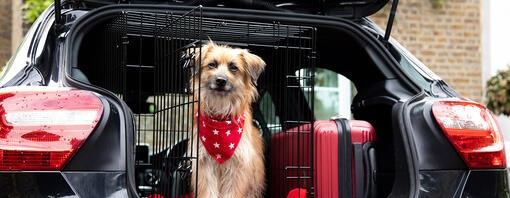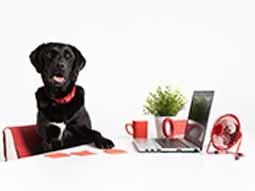Does Your Dog Get Car Sick? Understanding, Preventing and Managing Motion Sickness

For some dogs, car journeys are a regular part of their lives, whether it's daily trips to their favourite park for a walk or maybe going with their owners to a dog-friendly workplace. For other dogs, car travel might be a far rarer occurrence, a 'once in a blue moon' sort of thing. Either way, just like humans, dogs can get travel sickness too, and nothing makes a trip worse than having a dog in the back feeling poorly.
While you can usually find quick fixes for the immediate symptoms of car sickness, just focusing on stopping your dog from being vomiting in the car misses the bigger picture. Car travel, whether for pleasure or necessity is something that should be enjoyed and not be a trauma for you both.
Keep on reading to discover why dogs get travel sick, how to prevent it, what to do about it - and how to help make it a thing of the past.
Do Dogs Get Motion Sickness?
Yes, dogs absolutely can get motion sickness – and if they have not been introduced to the car and road journeys properly, it is more than likely.
Why Does My Dog Get Car Sick? Understanding the Causes
Car sickness is not uncommon – and let’s face it, whizzing down the road in a noisy metal box with the world flying past outside is hardly a natural thing for a dog! Most dogs who haven’t been slowly introduced to car travel can find it both strange and scary.
Past negative experiences with car travel
Often a dog’s first experience of car travel is as a puppy being forced into a car and taken on a long journey. The combination of the stress, the movement and the visual stimuli can often induce vomiting and/or diarrhoea. Or maybe on their first car journey, they are taken on a journey to the vet for vaccinations - which can produce stress. This immediately sets up a negative association with the car which, without working to change the dog’s emotional reaction to car travel from fear to pleasure, just gets worse and worse with every stressful repetition.
Lack of early habituation
Puppies who aren't properly introduced to being in a car and to car travel during their early habituation period when things are accepted as being a normal part of life, or early in their new life with their owner, often find car travel scary. The combination of being in a strange, enclosed space, with unfamiliar sounds, sights and smells coupled with the vibration and movement of the vehicle can lead to stress and sickness and/or diarrhoea.
To prevent this stress and sickness, cars – and being in a car - should be introduced slowly to a puppy as described later in this article. Prevention is always better than cure.
Visual triggers: passing traffic
The visual stimulation of things whizzing past the window and other fast-moving traffic, can be frightening or it can be totally over-stimulating for dog's sensitive to movement, such as herding breeds. This can trigger reactivity, extreme vocalisations, and an inability to settle. This is distracting for the driver as well as being stressful for the dog.
Inappropriate travel position and type of vehicle
It is important that your dog is both safe and comfortable in the car – and that you comply with the law. This means they must be secured. For most dogs and vehicles (hatchbacks, SUVs etc), the best place to travel is in a purpose-built crate behind the back seats. There they are safe and secure, able to settle and be comfortable, and also not distract you when you are driving.
This should be big enough that the dog can stand up and turn round and be able to lie down comfortably. It should be lined with veterinary bedding to make it a soft surface to lie on that won’t bunch up or slide around. For some dogs, having blinds on the rear side windows can help them be less aware of the outside world and other traffic whizzing past – as long as it doesn’t block your visibility as a driver.
This is usually the most appropriate traveling position for a dog as they are away from the engine and the worse of the noise and vibration – and can settle and lie down easily. Do be aware however that can air conditioning rarely reaches the area behind the back seats – so do check on this if you are driving on a hot day.
In other vehicles where you can’t put a crate behind the seats, you can get carriers that you can sit on the back seat that are secured by the seat belts.
While car harnesses are available for dogs, few have been crash tested and they don’t allow the dog to move about and change positions without getting tangled – and they are often distracting for the driver. The leading cause of seat belt fails is from dogs chewing on them and causing them to fray.
Associating the journey with negative locations
Dogs will associate car journeys with their destinations. If those destinations are consistently negative, such as the vet for painful of stressful procedures, they can begin to associate these with the car and so can develop a fear of travel leading to sickness.
In contrast, if the only journeys the dog goes on are highly exciting and arousing, they can become totally over-excited in the car.
Inner Ear Infection or other clinical issues
If your dog is usually a good traveller and they suddenly become car sick, visit your vet for a check-up. Conditions like ear infections can affect balance and the perception of motion – which can produce sickness. Also, if your dog is in pain or discomfort, car travel can exacerbate that. Similarly, if the dog is stressed in other areas of their life, car travel can just be the last straw even if they are usually fine in the car.
Symptoms of Motion Sickness in Dogs
Signs that your dog is getting stressed in the car can show themselves in subtle ways long before you see the obvious vomiting or diarrhoea. Here are some signs that you can look out for when traveling with your dog.
Recognising Subtle Signs Before Severe Symptoms
Spotting the subtle signs of stress or fear is important as this can lead to lead to an early recognition of your dog’s anxiety, which will allow you to prevent them from experiencing the more obvious and severe symptoms. Some of the early signs of stress you need to look out for at the prospect of a car journey include:
- Panting
- Lip licking
- Restlessness
- Whining
- Yawning
- Trying to escape or hide
- Refusing treats that they usually love
Addressing Car Sickness in Dogs Symptoms
When dogs experience advanced symptoms of motion sickness, it's a clear signal that they're in significant distress. These symptoms are obvious and include excessive drooling, panting, retching, diarrhoea, and vomiting.
Seeing any of these symptoms – subtle or more obvious - means it's time to pause all car travel and take some time to change your dog’s thoughts, feelings and associations with car travel. Continuing to expose your dog to these experiences will only reinforce their fear and anxiety and make things worse.
How to Help a Dog That Gets Car Sick
If your dog is already stressed or worried about car travel, refuses to get in the car, or shows any of the above symptoms, it is important that you spend some time going right back to basics and teaching them that the car is a safe place to be – and that car travel is enjoyable. By just ignoring the issues, it will get worse – as every journey that produces stress, anxiety and sickness, will further convince your dog that car travel is a horrible experience.
The introduction below works whether you have a puppy who has never been in a car, or a dog who is already worried about car travel and has shown signs of sickness.
Prevention is far better than cure
It is important to recognise that while we think of car travel as normal, for a puppy or a dog who has never travelled before, it is anything but. It’s noisy, smelly, visually and aurally overwhelming – and it moves and vibrates in very strange and scary ways.
The expectation should be that unless you take time to introduce your puppy or dog to the car, it is likely that they will be car sick or worried about car travel!
Step 1: Teaching your dog to be happy in the car
Before you even consider taking your dog for a ride in the car, it is important to make them feel confident and happy in this new environment. This takes a bit of preparation, so they learn that this is a great – and rewarding – place to be.
Introduce your puppy or dog to the car
- With all the doors open, start by putting them into the car in the area they will travel in, so they get to see it, sniff it and experience it. To start with, leave the back of the car or the door open and give them a few treats before taking them back into the house again. Repeat this a few times – until they are happy to eat the treats with the door closed with you inside with them.
- You can even put them in the car to have their dinner and then take them out again, so they make really positive associations.
- If they are happy with that, put them in the car with their dinner or a few treats as before and start the engine.
- When they’ve finished, take them out again.
- By doing this, they are already learning that the car is where good things happen – and that the engine noise and the vibration is nothing to worry about before you start adding external stimuli and movement.
Take them on a short slow trip in the car
- Put your dog in the car as before – and give them a couple of treats.
- Treats are a good indicator of how your dog is feeling. If a dog is stressed, they can’t eat!
- If you have a family member or a friend who can help, have them sit beside your dog to give them confidence.
- Start the engine and drive to the end of the road and back – no further!
- Give praise and rewards at the end of the journey.
- Repeat this several times so this becomes something ‘normal’ for your puppy that is always rewarding.
- If your puppy looks worried or stressed at any time, go back a few steps.
Going for a walk
- Repeat the above but go somewhere close by (no more than a mile) for a short walk.
- This helps teach your dog that the car is something that leads to having a fun outing and a great time together.
- If possible, have someone travel with you for the first few outings so they can sit beside your dog. This will give the puppy confidence and allow you to concentrate on the driving.
- Sometimes go on really boring trips too though (just a drive round and then come back). If you only drive to really fun places, your puppy can sometimes get too excited in the car and won’t settle, or else might get really noisy in their enthusiasm!
Slowly increase the length of your trips
Assuming all goes well, you can begin to go on longer or more frequent trips as your puppy’s confidence grows. If your puppy seems worried at any point, go back a few steps and just take things slowly.
This works well for puppies or dogs who are either new to car travel or who have minor car worries or sickness. For more serious established problems however just being near the car can be an issue.
In these cases, your initial goal is just to build some positive associations with just being around or near the car and not attempting to put them inside. This may take multiple sessions of rewarding them for just being in the vicinity of the car gradually decreasing distance over time before you attempt to put them in the car as above.
Don’t expect this to work overnight. Some puppies and dogs will take to car travel like a duck to water and will be happy to go on adventures in a few days. For others, especially those who already have travel worries, it could take a few weeks/months and a lot of patience to change your dog’s view of the car from something scary to something to look forward too – but it’s definitely worth it.
If at any point you think your dog is getting unduly stressed or they are not making any progress, consult a behaviourist for help.
Addressing Specific Triggers
Understanding your dog's specific triggers is key to creating a more positive car travel environment that will help them become better travellers. Knowing what your own dog’s stressors are when traveling will help. Is it movement from outside, is it an inability to settle, or is it the car itself?
Trigger 1: Visual Overstimulation
Some dogs find the sight of the world whizzing past outside (or other traffic) stressful or overly stimulating.
Solution: Use window shades or cover the sides of the crate/area where they travel to block the sight of other vehicles or other things outside.
Trigger 2: Inappropriate Travel Position/Unfamiliar Surroundings
An uncomfortable travel position or traveling in an inappropriate part of the car. This isn't just about physical discomfort; it's often about an inability to relax, lie down, get comfortable, or stay cool.
Solution: Change where in the car and how your dog travels. Rather than having them in a harness or in the footwell, try a secured crate either behind the seats or on the back seat secured with seatbelts. Make sure the crate/carrier is comfortably lined with veterinary bedding that won’t wrinkle up – and add a familiar blanket.
Trigger 3: Needing to go to the toilet
Solution: Ensure your dog has had the opportunity to go to the toilet immediately before traveling and make frequent stops for toilet breaks on longer journeys. This isn’t as easy as it sounds – as if a dog is worried about a journey, unsettled by the change in routine or over-excited, going to the toilet will be the last thing on their mind – and they only realise they need to go when they’re in the car and you’ve set off on the journey. Often owners don’t realise this – especially if they have just let the dog into the garden for a pee and just assume they’ve gone!
Avoid feeding your dog too close to travel time to prevent nausea, but always ensure fresh water is available.
Be mindful of overheating, especially in warm weather. Ensure good ventilation in the car in the area your dog is travelling, never leave your dog unattended in a parked car, and consider using fans if necessary.
Trigger 4: Physical discomfort
Solution: As dogs age, they often get joint degeneration or physical discomfort, making getting comfortable and staying in one position for a long journey, uncomfortable. Make sure traveling crates are well lined and padded, keep journeys short and give frequent breaks – and if you suspect your dog is in any pain, talk to your vet.
When to Seek Professional Help for Motion Sickness in Dogs
If you have worked through positive introductions and gradual acclimatisation and your dog continues to experience distress in the car, it's time to seek professional guidance.
If the issue is new or if travel is necessary and imminent (such as a relocation), consulting your vet is the first step. Often if travel sickness is a new issue and your dog usually travels fine, there may be a clinical issue such as an inner ear infection or pain.
Your vet can assess your dog's physical health and if the journey is imminent and important, may prescribe medication to help manage acute symptoms in the short term.
If your dog is showing:
- Severe or increasing anxiety or car phobia.
- Panic or fear approaching the car – or even at signs of an impending journey (picking up car keys etc).
- Aggression when trying to put dog in the car – or removing dog from car.
- Or they are just not getting any better when it comes to car travel.
consult a qualified and accredited behaviourist.
They can work with you and your dog to look at their specific issues and triggers and develop a behaviour plan to change your dog’s associations with car travel.
In addition to professional guidance, there are a variety of complementary therapies such as pheromone products designed or claiming to help calm anxious dogs but check with your vet before using them.
For dogs who don't exhibit signs of travel sickness but struggle to relax in the car, offering a stuffed Kong or other long-lasting, high-value chew can provide a positive enriching distraction that can help them settle during the journey.
Tips for Long Car Journeys
- Timing Meals: Avoid feeding your dog within an hour of travel.
- Pre-Travel Exercise: Take your dog for a walk to reduce their energy levels and make sure they get a chance to go to the toilet, so they are more likely to settle down and relax.
- Route Planning: Consider your route carefully. Avoiding motorways, while it might make your journey longer, will give you more options to stop when you need to and also will avoid the chance of long delays and being stuck in traffic jams with no shade and no way to keep your dog cool. In EV’s prolonged stationary air conditioning can quickly drain the battery, as they won't be regenerating power while stopped.
- Keeping Cool During Travel: Avoid travel during the hottest part of the day. Be particularly cautious as air conditioning rarely reaches the area behind the seats effectively, as it's primarily designed for front passengers. Check the airflow in your dog's travel area before you set off and use fans and shades if needed. If they are secured in a crate, you can open back windows.
- Frequent Stops: Take regular breaks in shaded areas. This is important not just for toileting and hydration but also to allow your dog to stretch their muscles and joints and get some fresh air.
- Hydration: Provide constant access to fresh water, refilling at stops.
Remember to follow the Dog Travel Checklist when taking your dog longer journeys, to make their experience as comfortable as possible.





